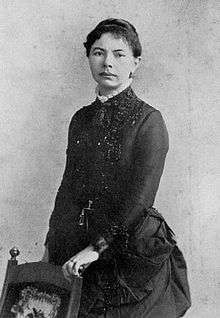Sarah Frances Whiting
Sarah Frances Whiting (August 23, 1847 – September 12, 1927) was an American physicist and astronomer. She was essential to the founding of the Whitin Observatory at Wellesley College, and was the instructor to several astronomers, including Annie Jump Cannon.
Sarah Frances Whiting | |
|---|---|
 | |
| Born | August 23, 1847 |
| Died | September 12, 1927 (aged 80) |
| Alma mater | Ingham University |
| Scientific career | |
| Notable students | Annie Jump Cannon |
Biography
Whiting graduated from Ingham University in 1865.
Whiting was appointed by Wellesley College president Henry Fowle Durant, one year after the College's 1875 opening, as its first professor of physics. She established its physics department and the undergraduate experimental physics lab at Wellesley, the second of its kind to be started in the country. At the request of Durant, she attended lectures at the Massachusetts Institute of Technology given by Edward Charles Pickering.[1] He invited Whiting to observe some of the new techniques being applied to astronomy, such as spectroscopy.[2] In 1880, Whiting started teaching a course of practical astronomy at Wellesley.
In 1895, as told by biographer Annie Jump Cannon,
An especially exciting moment came when the Boston morning papers reported the discovery of the Rontgen or X-rays in 1895. The advanced students in physics of those days will always remember the zeal with which Miss Whiting immediately set up an old Crookes tube and the delight when she actually obtained some of the very first photographs taken in this country of coins within a purse and bones within the flesh.
Between 1896 and 1900, Whiting helped Wellesley College trustee Sarah Elizabeth Whitin to establish the Whitin Observatory, of which Whiting became the first director.
Tufts College bestowed an honorary doctorate on Whiting in 1905.
Sarah Whiting was also known for supporting prohibition.
Whiting retired from Wellesley in 1916 and was a Professor Emeritus until her death in 1927 in Wilbraham, Massachusetts. She is buried in Machpelah Cemetery in Le Roy, New York, near her now-defunct alma mater, Ingham University.
Writings
Whiting wrote the textbook Daytime and evening exercises in astronomy, for schools and colleges.[4]
She was an author of several articles in popular astronomy, including:
- "Use of Graphs in Teaching Astronomy",[5]
- "Use of Drawings in Orthographic Projection and of Globes in Teaching Astronomy",[6]
- "Spectroscopic Work for Classes in Astronomy",[7]"The Use of Photographs in Teaching Astronomy",[8]
- "Partial Solar Eclipse, June 28, 1908",[9]
- Solar Halos,[10]
- "A Pedagogical Suggestion for Teachers of Astronomy",[11]
- "Priceless Accessions to Whitin Observatory Wellesley College",[12]
- "The Tulse Hill observatory diaries (abstract)",[13]
- "The Tulse Hill observatory diaries",[14]
She also wrote the obituary for Margaret Lindsay Huggins, "Lady Huggins".[15]
She described her experience as a "woman physicist" in the Wellesley College News article "The experiences of a woman physicist"[16]
Achievements
Honors:
- 1883 Member, American Association for the Advancement of Science (AAAS)
- 1905 Honorary doctorate, Tufts College
Tenures:
- 1876–1912 Professor of Physics, Wellesley College
- 1900–1916 Director, Whitin Observatory, Wellesley College
- 1916–1927 Professor Emeritus, Wellesley College
Education:
- AB Ingham University 1865
References
- Patricia Ann Palmieri (1995). In Adamless Eden. Yale University Press: New Haven.
- Klaus Hentschel (1999). The culture of visual representations in spectroscopic education and laboratory instruction. Physics in Perspective 1: 282-327 and (2002) Mapping the Spectrum. Oxford: OUP, pp. 385-393 on her spectroscopy classes.
- Annie J. Cannon (1927). "Sarah Frances Whiting." Science, Nov. 4, 1927, pp. 417-418.
- Whiting, Sarah Frances (1912). "Daytime and evening exercises in astronomy, for schools and colleges." Ginn and Company: Boston, New York, Chicago, London.
- Whiting, Sarah F. (1905). "Use of Graphs in Teaching Astronomy." Popular Astronomy, vol. 13, pp. 185-190.
- Whiting, Sarah (1905). "Use of Drawings in Orthographic Projection and of Globes in Teaching Astronomy." Popular Astronomy, vol. 13, pp. 235-240.
- Whiting, Sarah (1905). "Spectroscopic Work for Classes in Astronomy." Popular Astronomy, vol. 13, pp. 387-391.
- Whiting, Sarah (1905). "The Use of Photographs in Teaching Astronomy." Popular Astronomy, vol. 13, pp. 430-434.
- Whiting, S. F. (1908). "Partial Solar Eclipse, June 28, 1908." Popular Astronomy, Vol. 16, 1908, p. 458.
- Whiting, Sarah F. (1909). "Solar Halos." Popular Astronomy, Vol. 17, 1909, p. 389.
- Whiting, Sarah F. (1912).
- "A Pedagogical Suggestion for Teachers of Astronomy." Popular Astronomy, vol. 20, pp. 156-160.
- Whiting, Sarah F. (1914). "Priceless Accessions to Whitin Observatory Wellesley College." Popular Astronomy, vol. 22, pp. 487-492.
- Whiting, Sarah Frances (1917). "The Tulse Hill observatory diaries (abstract)." Popular Astronomy, Vol. 25, p. 117.
- Whiting, Sarah Frances (1917). "The Tulse Hill observatory diaries." Popular Astronomy, Vol. 25, p. 158.
- Whiting, Sarah F. (1915). "Lady Huggins." Astrophysical Journal, vol. 42, p. 1.
- Sarah Frances Whiting. "The experiences of a woman physicist." Wellesley College News, Jan. 9, 1913, 1-6.
Further reading
- Sopka, Katherine R.; Watkins, Sallie A.; Kidwell, Peggy A.; Guernsey, Janet B. (1984). Lotze, Barbara (ed.). Making contributions : an historical overview of women's role in physics. American Association of Physics Teachers. ISBN 9780917853098.
- Shearer, Benjamin F (1997). Notable women in the physical sciences. Westport CT: Greenwood Press.